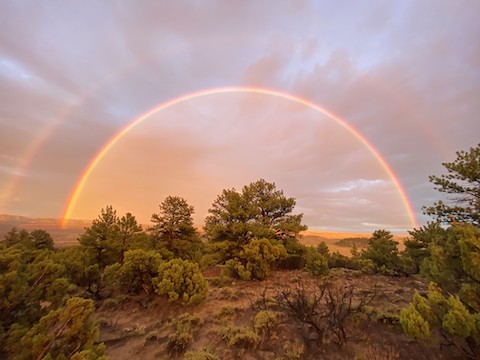
There’s an Irish saying, “There’s a pot of gold at the end of every rainbow.”
But it used to say, “you’re as likely to find a pot of gold as the end of the rainbow.”
That’s because if you go looking for its end, the rainbow vanishes.
Rainbows occur when water droplets—from rain, mist, waterfalls, even sea spray—hang in the air.
When sunlight enters the droplet, some will reflect off the back side and pass again out the front.
As sunlight passes twice through the water, the different wavelengths that make it up bend at different angles, which splits the entering white light into the spectrum of rainbow colors.
Your position, in relation to the sun and the water droplet, affects how much and which light reaches your eyes. Meaning, you determine how much rainbow you see.
If the sun is directly behind you, and low in the sky, the largest amount of light is reflected back toward you, and you’ll see a strong rainbow.
If the sun is 90 degrees to your right or left, you’ll see less reflected light and a weak rainbow.
If the sun is high in the sky or on the other side of the water droplets, no light reflects back to you, and you’ll see no rainbow.
This also means that, as you move, the amount of rainbow you see changes.
If you travel far enough toward what appears to be its end, the rainbow, and your pot of gold, will gradually disappear.
Background
Synopsis: Rainbows are spectacular natural light shows that are customized for every viewer because the location of your eyes is part of the equation. With the sun at your back, water droplets in mist spread the visible spectrum of light out, reflecting colorful circular arcs of light. As an observer moves, the rainbow appears to move also, prompting the seventeenth-century Irish saying that “you are as likely to find a pot of gold as to find the end of the rainbow,” later modified to promise a pot of gold at the end of the rainbow.
- Rainbows are glorious visual displays that may occur when the sun shines through any type of mist.
- They typically occur in vapor-rich air that remains after rainstorms, but they may also occur at the base of waterfalls as fog lifts and even in the steam clouds of geysers.
- They may also occur along seacoasts from sea spray.
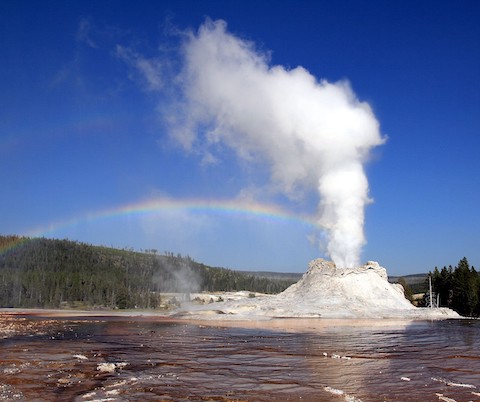

- Rainbows don’t occur at a particular place in the sky; they are an optical phenomenon.
- The sight of a rainbow depends on the relationship between the location of the viewer’s eye, the location of the sun and the location of water droplets in the air.
- Since around 350 BC, scientists like Aristotle have puzzled through the mystery of rainbow formation, including Asian and Middle Eastern scholars.
- In 1637, René Descartes published his “Discourse on Method” where he described how rainbows might form, coming close to modern models.
- In the late 1600s, Isaac Newton contributed to the understanding of how white light could be separated into the spectrum of the rainbow.
- In 1908, the concept of Mie scattering aided physical descriptions of rainbows.
- The most recent treatise on rainbows was published as recently as 1977.
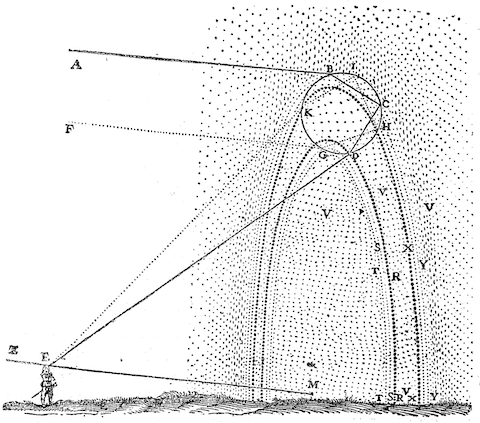
- Colors of the rainbow form when light enters water droplets suspended in air, each one acting like a tiny prism.
- When light enters a water droplet, it refracts (or bends) as it goes from air into a denser water droplet, where it has to travel more slowly.
- The angle of refraction is different for different wavelengths, so the light splits into different bands.
- Longer wavelength red bends less while shorter wavelengths like yellow and blue bend progressively more.
- Then the various wavelengths of light reflect off the back of the water droplet.
- As they leave the droplet, the different wavelengths are refracted again, speeding up as they move back into air.
- Overall, the light is reflected back toward the observer at an angle of around 42° in pure water, and this angle is key to how we perceive rainbows.
- In liquids with higher refractive indices like salt water, the reflection angles decrease.
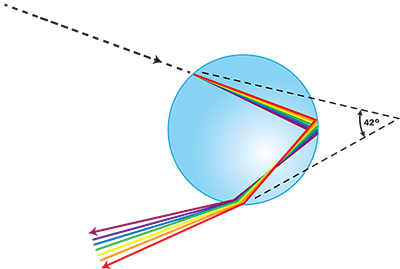
- Rainbows are actually circular in shape but humans standing on the ground can only see the top half of the arc.
- All raindrops, regardless of size, refract and reflect sunlight the same, but the observer only sees the spectrum of light from some of them.
- The phenomenon is created by the spectrum of light from those raindrops that are viewed at a right angle by the observer, and these lie on a cone with the observer’s eye at the apex, increasing in diameter along an axis that extends directly away from the sun to the center of the rainbow, called the antisolar point.
- The rainbow is curved because of the cone shape of this spectacle, but it varies for every observer.
- If a person appears to be standing at the end of an observer’s rainbow, that person will see their own rainbow defined by a cone of color with their own eyes at the apex of the cone.
- This is the source of the seventeenth-century Irish saying that “you are as likely to find a pot of gold as to find the end of the rainbow,” which was adapted through centuries of storytelling to suggest that there is a pot of gold at the end of the rainbow.
- The shortest violet wavelength bends the most, so it ends up in the center, while longer wavelengths like red end up on the outside edge of the rainbow.
- We only usually see the top half of the cone of color.
- At sunrise or sunset, rainbows appear to extend 42° above the horizon, directly opposite to the sun.
- When the sun is higher in the sky, the arc of the rainbow appears smaller and smaller.
- If the sun is higher than 42° above the horizon, rainbows are not visible.
- Sometimes full circle rainbows can be viewed from vantage points high on cliffs or in an aircraft.
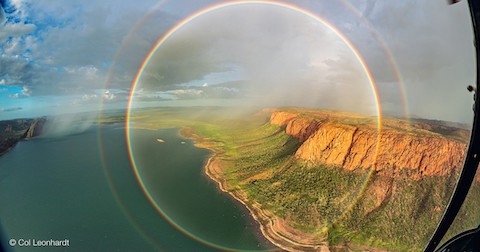
- Rainbows display a continuous spectrum of electromagnetic wavelengths, including radio, infrared, visible light, ultraviolet (UV), x-rays and gamma radiation.
- We see the visible spectrum in rainbows: red, orange, yellow, green, blue, indigo, and violet (remember this sequence using the mnemonic ROY G BIV).
- Scientists use spectrometers to study the invisible parts of rainbows both inside the violet (UV, x-rays and gamma radiation) and outside of the red (radio and infrared) parts of the rainbow.
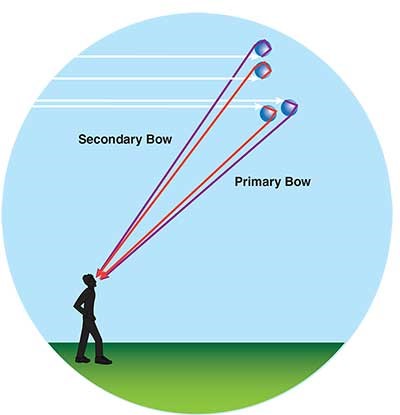
- So, if you want to see a rainbow, there are a few important points to take away from this EarthDate episode:
- Water droplets must be floating in the air.
- The sunlight must be hitting the droplets.
- The sun must be below 42° above the horizon to see the spectacle.
- Stand with the sun at your back, and the water droplet source in front of you, and enjoy the show!
- And if there is a bright full moon, the same concepts apply, you may be able to see a moonbow!

